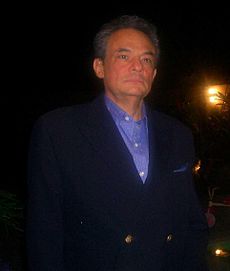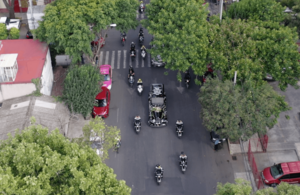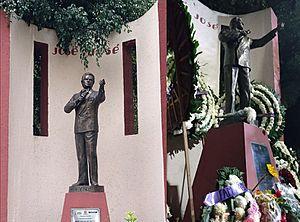José José facts for kids
Quick facts for kids
José José
|
|
|---|---|
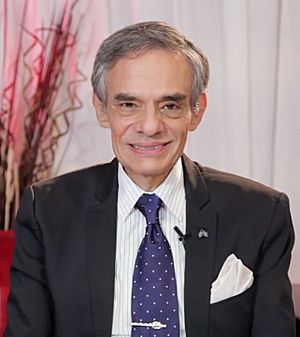
José José, c. 2017
|
|
| Born |
José Rómulo Ortiz
17 February 1948 Clavería, Azcapotzalco, Mexico City, Mexico
|
| Died | 28 September 2019 (aged 71) Homestead, Florida, U.S.
|
| Resting place | Panteón Francés de San Joaquín Mexico City, Mexico |
| Occupation |
|
| Years active | 1963–2012 |
| Spouse(s) |
Natalia Herrera Calles
(m. 1970; div. 1975)Anel
(m. 1976; div. 1991)Sara Salazar
(m. 1995) |
| Children | 3 |
| Musical career | |
| Genres |
|
| Instruments |
|
| Labels |
|
| Associated acts |
|
| Signature | |
 |
|
José Rómulo Sosa Ortiz (born 17 February 1948 – died 28 September 2019), known professionally as José José, was a famous Mexican singer and actor. He grew up in a family of musicians. José started his music journey as a teenager, playing guitar and singing. He later joined a jazz and bossa nova music group. In this group, he sang and played the bass and double bass.
José José became very successful as a solo artist in the early 1970s. He showed off his amazing tenor voice with a fantastic performance of the song "El Triste" at a Latin music festival in Mexico City in 1970. After this, his songs quickly became popular on Latin music charts. He became known for singing romantic ballads. Music experts and the media praised his singing.
In the 1980s, José became famous around the world after signing with Ariola Records. His 1983 album Secretos sold more than twenty-five million copies. He had many international hit songs and received several Grammy nominations. He performed for huge crowds in places like Madison Square Garden and Radio City Music Hall. His music even reached countries like Japan, Israel, and Russia. He also became an actor, starring in movies like Gavilán o Paloma (1985) and Perdóname Todo (1995).
People in the entertainment world called him El Príncipe de la Canción (The Prince of Song). His singing style and performances have inspired many Latin pop artists. His career lasted over forty years. Many Latin fans and media saw José José as a true icon of Latin pop music. They considered him one of the best and most important Latin singers of all time. His death was a very sad event for his many fans in Mexico and other countries.
Contents
Early Life and Music Career
Childhood and Family
José Rómulo Sosa Ortiz was born on 17 February 1948. His birthplace was Clavería, a neighborhood in Azcapotzalco, Mexico City. His father, José Sosa Esquivel, was an opera singer. His mother, Margarita Ortiz, was a classical pianist. When José showed interest in singing, his parents tried to tell him it was hard to succeed in show business. Around that time, his father left the family. José had to work to help his mother and younger brother.
Starting as a Singer (1963–1969)
At fifteen, José's mother gave him his first piano. While working as a teenager, he learned to play the guitar. He also sang in the church and performed serenades with friends. This helped him earn extra money.
In 1967, at age 19, José formed a Mexican band called Los Peg. They played bossa nova and jazz music. The band recorded some songs, but they were not very popular. In 1965, José tried to start a solo career. He used the name "Pepe Sosa" and released two songs, "Ma vie" and "El Mundo," but they didn't become hits.
His big break came when he sang for a friend's sister's birthday. His friend's sister worked for the head of Orfeón Records. José then combined his first name, "José," with his father's first name, also José. He signed a contract with RCA Victor. He recorded his first album, José José (also known as Cuidado). This album included songs by famous composers like Rubén Fuentes and Armando Manzanero. His former teacher, Mario Patrón, who was a top jazz musician in Mexico, arranged the music. The album also featured Brazilian percussionist Mayuto Correa. The album mixed boleros and romantic ballads with jazz and bossa nova sounds. Critics praised his first album, but it did not become very popular with the public.
"El Triste" and Growing Fame (1970–1980)
In early 1970, José released "La nave del olvido." This song became his first big hit in Mexico and Latin America. He then recorded his second album, La Nave Del Olvido. José's career truly took off on 15 March 1970. He represented Mexico at the II Festival de la Canción Latina (Latin Song Festival II). This festival was a big international song contest. He performed the song "El Triste" with great emotion. Even though he placed third, his performance made him famous to a much wider audience.
Throughout the 1970s, José José had many major hits. These included "De Pueblo en Pueblo," "Hasta Que Vuelvas," "Déjame Conocerte," "Sentimientos," "Paloma," and "Gavilan o Paloma." One song, "El Príncipe" ("The Prince"), was played so often on the radio that a DJ gave him the nickname "El Príncipe de la Canción" ("The Prince of Songs").
In 1973, Frank Sinatra heard José's music. Sinatra was impressed and invited him to record a duet and a full album. However, José could not do it because of his contract with his own record label. In 1976, José signed with Ariola Records. His first album with them, Reencuentro, came out a year later.
International Success and Secretos (1980–1989)
José José released several successful albums in the 1980s. These included Amor Amor (1980), Romántico (1981), Gracias (1981), and Mi Vida. The Amor Amor album sold over 1.5 million copies in Latin America. He also recorded a Spanish version of "New York, New York" as a tribute to his friend Frank Sinatra.
In 1983, José José released Secretos. For this album, he worked with the famous composer Manuel Alejandro. Songs like "Lo Dudo" ("I Doubt It") and "El Amor Acaba" ("The Love is Over") became huge hits. Secretos became his best-selling album ever, selling four million copies. It was even nominated for a Grammy Award in 1985. After Secretos, José continued his international success. In 1984, he released Reflexiones. This album was written and produced by Rafael Pérez-Botija. It sold over 2 million copies worldwide. Reflexiones was the first album to reach number one on the Billboard Latin Pop Albums chart in the United States in 1985. It was also nominated for a Grammy Award in 1986.
In 1985, José José joined other famous singers like Plácido Domingo and Julio Iglesias. They recorded a charity song called "Cantaré, cantarás." He also sang a duet with Puerto Rican singer José Feliciano called "Por Ella" ("For Her"). This song was on Feliciano's album Ya Soy Tuyo (1985) and was also nominated for a Grammy. The same year, José starred in his own movie, Gavilán o Paloma. It was about his life and featured actors like Christian Bach. The next year, he released the album Promesas. Its main hits were "Amantes," "Me vas a echar de menos," and "Más." One song, "Pruébame," was nominated for a Grammy in 1987. Promesas became his second number-one album on the Billboard Latin Pop Albums chart.
His next album, Siempre Contigo (1986), was made with Spanish producer Paco Cepero. It had three hit songs: "¿Y Quién Puede Ser?", "Corre y Ve Con Él," and "Sin Saber." "¿Y Quién Puede Ser?" became his first number-one song on the Billboard Hot Latin Songs chart in the United States. It was nominated for a Grammy in 1988. This album also became his third number-one album on the Billboard Latin Pop Albums chart.
José José shared with Selecciones magazine that from 1985 to 1987, he faced personal challenges. He felt his life was constantly moving between airplanes and hotels. His daughter was born in 1982, which helped his marriage for a while. However, he later divorced his wife. During this time, he also stopped working with his manager, who was also his brother-in-law. Despite these events, José José recorded his album Soy Así. It became his fourth number-one album on the Latin Pop Albums chart. The album included four hit songs: the title track (which became his second number-one song on the Hot Latin Songs chart), "Mi Hembra," "Salúdamela Mucho," and "Vergüenza Me Da Quererte." Soy Así was nominated for a Grammy in 1989. It also won Pop Album of the Year at the 1st Annual Lo Nuestro Awards. José José was also named Pop Male Artist of the Year.
José José played the role of Mexican singer Álvaro Carrillo in the movie Sabor A Mí. In 1989, José José released ¿Qué Es El Amor?. It included three hit songs: "Como Tú", "Piel de Azucar," and "Él." "Como Tú" stayed at number one on the Hot Latin Songs chart for ten weeks. It was nominated for Pop Song of the Year at the 1990 Lo Nuestro Awards.
Later Career and Health (1990–2012)
In 1990, Raúl Velasco created a special TV show to celebrate José's 25th year in music. The show, on Televisa, lasted over five hours. It featured special guests like Armando Manzanero and Vicente Fernández. Later that year, he released En las Buenas... y en las Malas. The main song, "Amnesia", reached number one on the Hot Latin Songs chart. Two years later, he released 40 y 20. The title song talks about older men falling in love with much younger women. It also describes how society reacts to these relationships.
By the early 1990s, José's singing voice began to weaken. This became clear during his live shows. His voice problems grew worse over time. In August 1993, BMG held a tribute for José's 30th career anniversary. It was called 30 Años de ser el Príncipe (30 years of being the Prince). Famous Spanish artists like Rocío Dúrcal and Camilo Sesto attended. José looked very thin and tired. Camilo Sesto even paused his performance to offer words of encouragement. The album from this tribute was released in 1994. José retired from performing on stage during 1993.
In 1994, José José worked again with Manuel Alejandro. They released the album Grandeza Mexicana. The title song reached number 12 on the Hot Latin Tracks chart. He also sang a duet with his son, José Joél, called "La Fuerza de la Sangre." In 1995, he played the main role in the movie Perdóname Todo. That same year, his album "Mujeriego" came out. It sold over 180,000 copies in its first two weeks. It reached number 12 on the Billboard Latin charts. The song "Llora Corazón" reached number 6 on the Hot Latin Songs chart. It was nominated for Pop Song of the Year at the Lo Nuestro Awards.
In 1996, he sang a duet with Paul Anka called "Déjame Conocerte." In 1997, he performed at the Bally's Atlantic City. In September 1999, he joined other Mexican singers like Armando Manzanero. They performed a series of concerts called "Noche Bohemia" (Bohemian Night) in Los Angeles.
In 2001, with his voice still weakening, he recorded Tenampa. This was his first album with mariachi music. It was also the last studio album of his career. Juan Gabriel wrote and produced the entire album. It received poor reviews and sold only about 500,000 copies. After this, he stopped recording full albums. His voice problems got worse, making it hard for him to sing and even speak. In 2003, BMG released a collection of three albums called El Principe Con Trio. It featured some of his greatest hits from 1969 to 1983. The original music was removed, and the songs were re-recorded with the guitar trio "Los Tres Caballeros." This turned them into boleros.
In the mid-2000s, he played Erasmo Padilla in La Fea Más Bella. This was a popular Mexican TV show based on the Colombian show Betty la Fea. In 2007, he won a TVyNovelas Award for best supporting actor for his role.
In 2008, José recorded an emotional song called "Volver a creer" ("Believe Again") with Greek composer Yanni. The song is on the album Yanni Voices. Yanni said he wanted to "help a true legend to fulfill his dream, to sing again." José José was invited by Yanni to sing their song live on Yanni's tour in Mexico. He also published his autobiography called Esta es mi vida (This is My Life).
In 2010, he released José José Ranchero. This was another album where his classic hits were re-recorded with mariachi music. This gave his songs a traditional Mexican sound. The same year, José launched his own perfume, simply called "José José." Money from the sales helped women and children with HIV/AIDS.
José was planning a new album with nine new songs. He also wanted to include a song he used to sing in serenades, "Que viva mi tristeza," by Armando Manzanero. However, the album was never finished because of his voice problems. In 2011, he went on a short Mexican tour called "José José y sus amigos" (José José and friends). He performed with singers like Dulce and Carlos Cuevas.
In 2012, José celebrated his 50-year career. He gave a concert at the Hard Rock Hotel & Casino in Miami. This was his final live performance.
Personal Life
Financial Challenges
In his later years, José openly spoke about his money problems. His income from live shows decreased when he lost his singing voice. He said that throughout his career, people close to him, including his former wife Anel, had cheated him. In November 2008, his wife had a serious health issue. José said that the medical bills almost made him go bankrupt. He told TV Notas magazine that he and his family lived "day to day." In 2014, he sold his large house in Coral Gables, Florida. He then moved to an apartment in Miami.
Health Issues
José José had a severe case of pneumonia in 1972. This caused his thoracic diaphragm (a muscle used for breathing) to become paralyzed. The illness almost ended his career. He recovered after months of breathing exercises. However, one of his lungs was permanently damaged. In 1987, he had surgery to remove growths on his vocal cords. This was due to using too much cortisone before singing and not resting enough after performances.
His health worsened in the 1990s. He developed diabetes. His ability to talk was also affected. In 2007, he suffered from Bell's palsy, which caused weakness in his face. Because of all these problems, he struggled with serious depression. He talked about this in an interview on the Univision show Don Francisco Presenta.... He also had problems with his vision due to diabetes. He had a successful operation for diabetic retinopathy in one eye. In 2012, he had surgery for gastritis. In November 2013, he had an operation to remove cataracts from one of his eyes.
Relationships and Family
In 1970, José started a relationship with TV host and actress Ana Elena Noreña, known as Anel. They later separated, and he married Natalia "Kiki" Herrera Calles, who was 20 years older. He separated from Herrera and returned to Anel shortly after. He divorced Herrera in 1975 and married Anel in 1976. They had two children: their son José Francisco (known as José Joél), born in 1975, and their daughter Marysol Estrella, born in 1982. In 1991, he divorced Anel. Four years later, he married Sara "Sarita" Salazar, his third wife. Their third child, Sara, was born that same year during a Latin American tour. He lived in Miami, Florida, with his wife.
Illness and Death
In March 2017, José José announced he had been diagnosed with pancreatic cancer. On 28 September 2019, José José sadly passed away from the disease at a hospital in Homestead, Florida. He was 71 years old. His death was a great shock to Mexico. Within hours, it became a national trending topic on social media. Many famous people, artists, athletes, and politicians shared their sadness. The President of Mexico, Andrés Manuel López Obrador, said that "his voice moved a lot of people." He also said that "the best tribute is to keep remembering him and listening to his songs."
On 4 October, a funeral for José was held in Miami for his family and close friends. José was cremated on 8 October. On the same day, his death certificate was released. His ashes were divided, with some staying in Miami and the rest flown back to Mexico.
On 9 October, half of his ashes were flown back to Mexico City on a Mexican Air Force military plane. A black hearse carried his gold-plated casket from the airport to the city center. Fans threw flowers and waved as the vehicle passed. A three-hour tribute was held at the Palace of Fine Arts. The Mexican Culture Ministry planned the event. Members of the National Symphony Orchestra played some of his famous ballad songs, including "El Triste." Artists from Mexico's Opera Studio of Fine Arts also honored the singer. Many famous people, including Emmanuel, Dulce, and Lucia Mendez, attended to say goodbye. The ashes were then taken to the Basilica of Our Lady of Guadalupe for a mass. After that, the family led a funeral procession through the singer's old neighborhood. His ashes were finally buried at the Panteón Francés de San Joaquín in Mexico City.
Music Style and Voice
José grew up listening to many types of music. These included traditional pop music, rock and roll, jazz, swing, and big band. He enjoyed artists like Elvis Presley and Frank Sinatra. He also liked Mexican composers such as Consuelo Velázquez. His parents were a singer and a pianist. He listened to classical composers like Chopin and Mozart. In his teenage years, José learned to play music from top Mexican jazz players. He was known for playing several instruments, including the piano, bass, guitar, and double bass. People described him as "a singer who sings as a musician" because of his musical phrasing.
His Amazing Vocals
In his autobiography, Ésta es mi vida, vocal coach Guido Picco described José José as a light lyric tenor. José also worked with coach Seth Riggs, who praised his vocal skills. Over time, his voice and singing style changed. His best singing period was in the early 1970s. He inherited his father's singing talent. He could easily reach high and low notes with almost perfect pitch. His live performance of "El Triste" in 1970 has been widely praised. Critics admired his technique and the strong emotion he put into the song. His breathing technique allowed him to hold long, clear notes.
After recording "El Triste" for his 2010 album Iconos, singer Marc Anthony said, "once you start to sing it you realize the magnitude, of that spectacular voice and special phrasing of José José and his incredible way to perform." On the Latin VH1 show Las 100 grandiosas canciones de los 1980s en español (The 100 Greatest Spanish Songs of the 1980s), singer Diego Verdaguer said: "If today he could sing, he would be the greatest of Latin America." In a 2018 interview, singer Lupita D'Alessio called José "an icon, the master, the creator of phrasing." She added, "he's got a way of phrasing that there will not be another, for me, he is the greatest singer ever." D'Alessio also highlighted his excellent breathing technique and ability to hold long notes.
Legacy and Tributes
The music of José José is very well known in the Hispanic community. Many artists have said that José influenced their music. These include Cristian Castro, Vicente Fernández, Alejandro Fernández, Marc Anthony, and many others.
In 1997, José was added to the Billboard Latin Music Hall of Fame. He received the Billboard Latin Music Lifetime Achievement Award in 2013. In 2002, José José received the Excellence Award at the 14th Annual Lo Nuestro Awards. He was also inducted into the International Latin Music Hall of Fame. In 2004, he received the Latin Grammy Lifetime Achievement Award. A year later, he was named Personalidad del Año (Person of the Year) by the Latin Recording Academy.
In 2006, Televisa produced a TV tribute to José José in Acapulco. Singers like Manoella Torres performed his greatest hits live. In July 2008, Univision and the Latin Grammy recorded a special TV tribute in Miami. It was called Latin Grammy Celebra: José José. Stars like Marco Antonio Solís and Luis Fonsi performed his songs. Other stars like Plácido Domingo and Ricky Martin sent messages of admiration. Univision called José José "One of the most beloved singers in Latin music."
In 2007, a bronze statue was placed in his honor in Azcapotzalco, Mexico City, where he grew up. He was honored by the Las Vegas Walk of Stars with a celebrity star in 2008.
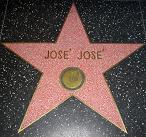
In February 2004, José José received a star on the Hollywood Walk of Fame. This was for his contributions to the music industry. He was given the Living Legend Award by the Latin Songwriters Hall of Fame in 2019 after his death.
Musical Tributes
Latin rock and hip hop artists like Molotov and Julieta Venegas recorded a tribute album in 1998. It was called Volcán: Tributo a José José (Volcán: Tribute to José José). Each artist recorded one of José's classic songs, like "Lo Dudo" or "El Triste," in their own style. It sold over 500,000 copies. Fifteen years later, in November 2013, a follow-up album called Un Tributo 2 was released. It featured artists like Natalia Lafourcade and Moderatto.
On 30 November 2010, Mexican singer Cristian Castro released Viva el Principe (Long Live the Prince). This album included a virtual duet with José José on "Lo Pasado, Pasado." It also had a poem recited by José. In the poem, José says that a singer cannot live if he cannot sing. This was a sad reference to him losing his singing voice. Rafael Pérez-Botija helped produce the album. The success of Viva el Principe helped Cristian Castro's career. Castro later released another tribute album to José José called Mi Amigo El Príncipe (My friend the Prince).
In 2009, Kalimba recorded an album called Amar y Querer: Homenaje A Las Grandes Canciones (Love and Desire: A Tribute to the Great Songs). It featured some of the most famous Latin ballads, including José's "Amar y querer," "Desesperado," "Volcán," and "El Triste."
On 25 October 2019, 100,000 people gathered in the Zócalo of Mexico City to honor José, even during a rainstorm.
Film and Television Appearances
| Year | Title | Role | Notes |
|---|---|---|---|
| 1972 | Buscando Una Sonrisa | Film | |
| 1972 | Un sueño de amor | David Granados | Film |
| 1974 | La carrera del millón | Film | |
| 1977 | Variedades de media noche | Singer | Episode: "El príncipe de la canción" |
| 1983 | Los secretos de José José | Himself | Film |
| 1984 | Siempre en domingo | Himself | Film |
| 1985 | Gavilán o Paloma | José Sosa "José José" | Film |
| 1988 | Sabor a mí | Alvaro Carrillo | Film |
| 1995 | Perdóname Todo | Film | |
| 2005 | Sueño | Mystery Musician | Film |
| 2006 | Double Tap | Mob Leader | Film |
| 2006–2007 | La fea más bella | Erasmo Padilla | TV Series; Co-lead role |
| 2007 | Objetos perdidos | Singer | Voice, Episode: "Objeto 1" |
| 2009 | Melate el corazón | Himself | Film |
Selected Albums
| Year | Title | Label |
|---|---|---|
| 1967 | Los PEG | RVV EP1 (México) |
| 1967 | Anina y Pepe Sosa | Orfeon (México) |
| 1969 | Cuidado | RCA (México)/Arcano Records (US) |
| 1970 | La Nave del Olvido | RCA (México)/Arcano Records (US) |
| 1970 | El triste | RCA (México)/Arcano Records (US) |
| 1971 | Buscando una sonrisa | RCA (México)/Arcano Records (US) |
| 1972 | De pueblo en pueblo | RCA (México)/Arcano Records (US) |
| 1972 | Cuando tú me quieras | RCA (México)/Arcano Records (US) |
| 1973 | Hasta que vuelvas | RCA (México)/Arcano Records (US) |
| 1974 | Vive | RCA (México)/Arcano Records (US) |
| 1975 | Tan cerca... Tan lejos | RCA (México)/Arcano Records (US) |
| 1976 | El príncipe | RCA (México)/Arcano Records (US) |
| 1977 | Reencuentro | Ariola (México)/Pronto Records (US) |
| 1978 | Volcán | Ariola (México)/Pronto Records (US) |
| 1978 | Lo pasado, pasado | Ariola (México)/Pronto Records (US) |
| 1979 | Si me dejas ahora | Ariola (México)/Pronto Records (US) |
| 1980 | Amor, amor | Ariola (México)/Pronto Records (US) |
| 1981 | Romántico | Ariola (México)/Pronto Records (US) |
| 1981 | Gracias | Ariola (México)/Pronto Records (US) |
| 1982 | Mi vida | Ariola (México)/Pronto Records (US) |
| 1983 | Secretos | Ariola (México/US) |
| 1984 | Reflexiones | Ariola (México/US) |
| 1985 | Gavilán o paloma | Ariola (México/US) |
| 1985 | Promesas | Ariola (México/US) |
| 1986 | Siempre contigo | Ariola (México/US) |
| 1987 | Soy así | Ariola (México/US) |
| 1988 | Sabor a mí | Ariola (México/US) |
| 1989 | ¿Qué es el amor? | BMG Ariola (México/US) |
| 1990 | En las Buenas... y en las Malas | BMG Ariola (México/US) |
| 1992 | 40 y 20 | BMG Ariola (México/US) |
| 1994 | Grandeza mexicana | BMG (México/US) |
| 1995 | Mujeriego | BMG (México/US) |
| 1997 | Tesoros | BMG (México/US) |
| 1998 | Y algo más | BMG (México/US) |
| 1998 | Distancia | BMG (México/US) |
| 2001 | Tenampa | BMG (México/US) |
Images for kids
See also
 In Spanish: José José para niños
In Spanish: José José para niños


